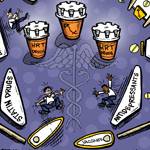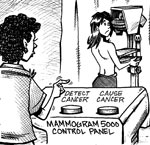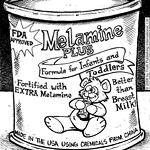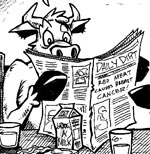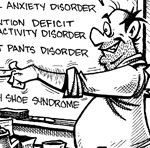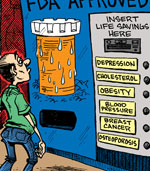Essential Vitamin D3 Information Even Your Doctor May Not Know About
| Share on Facebook | Share on Twitter | Share on Google+ |
What is vitamin D3? What is enough vitamin D3? Can you overdose on vitamin D? What is the essential vitamin D3 information that you need know. All of these questions and more are answered here.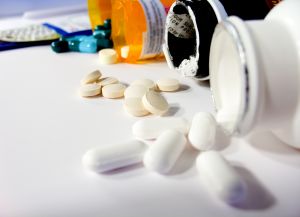
What is Vitamin D3?
It's almost impossible not to have heard about vitamin D. Widely advertised as the potential cure of cancer, autoimmune diseases, osteoporosis, diabetes, and even the common cold, this "sunshine vitamin" is the most talked about nutrient in the world today. .
The term vitamin D can refer to a form of the vitamin also known as vitamin D2 or the form of the vitamin known as vitamin D3, or both. When your skin uses the UV-B rays of the sun to turn a compound called 7-dehydrocholesterol (made from cholesterol) into vitamin D, the form of the vitamin it makes is D3.
When a mushroom makes vitamin D as a kind of natural sunscreen to protect it from drying out, the form of the vitamin it makes is D2. The human body can use both forms of the vitamin, but most of the vitamin D we consume is D3.
What Does Vitamin D3 Do In the Human Body?
Vitamin D3 is both a hormone and a vitamin. The body stores vitamin D3 in a form called 25 (OH) vitamin D. It is also known as 25-hydroxy vitamin D. The body uses vitamin D3 in a form called 1,25 (OH)2 vitamin D. It is also known as 1,25-dihydroxy vitamin D.
You have over a thousand times more of the storage form of vitamin D than you have of the active form of vitamin D if you have enough of the vitamin. Only tiny amounts of D are activated by the kidneys and sent out to the rest of the body through the bloodstream.
You can have lots of the active form even when your body is running low on the storage form. Just because you don't have a deficiency right this very minute does not mean you won't have a deficiency in the near future.
The active form of vitamin D is essential in human health:
- It activates the hormones that regulate absorption and release of calcium from cells.
- It activates the receptors that respond to hormones in the brain, reproductive organs, breasts, and heart.
- It activates the processes that make nitric oxide, the healthy free radical that keeps blood vessels open and relaxed.
- It activates and accelerates the maturation of certain white blood cells that fight both infections and cancer.
Vitamin D is a hormone-like substance that helps the rest of the body respond to hormones. If you don't have the hormones, vitamin D won't really help you. But if you don't have the vitamin D, having the hormones isn't enough.
What Is Enough Vitamin D?
If you read the natural health news, you would get the impression that nobody gets enough vitamin D and everybody needs more, more, more. This just is not true. If you get sunlight exposure every day (when the UV factor is over 3, the UV factor something you can find in your local weather forecast), and you aren't eating so little food that your body can't make cholesterol, chances are your body will make all the vitamin D you need.
Here are the minimums:
- Children need 200 IU (5 micrograms) of vitamin D a day to prevent the bone conditions known as rickets.
- Adults generally need 600 IU (15 micrograms) of vitamin D to prevent deficiency.
The US recently raised its recommended daily intakes of vitamin D to levels that prevent adult deficiency diseases. Australia and New Zealand have similar recommendations. The European Union just recommends enough vitamin D to prevent rickets in children. But some people need more than the minimum. The problem is, not everybody lives where there is sunlight, not everybody has a chance to get sunlight, and various life stresses "eat up" vitamin D so your body can be temporarily deficient. People who are especially like to need extra D include:
- People who don't get enough sun so their skin can make vitamin D, and
- People who are overfat, fat "catching" vitamin D out of circulation.
Even without taking any kind of lab test, it's safe for any healthy child to be given up to 1,000 IU (25 micrograms) of D and for any healthy adult to take up to 5,000 IU (125 micrograms) of D a day. It is possible, however, to take too much.
How Much Vitamin D Is Too Much?
One of the reasons that the European Union bans use of larger doses of vitamin D is a long history of vitamin D overdoses in Europe. At one time, butchers sprinkled vitamin D powder on older cuts of meat and ground meat to turn green meat red. The vitamin D in the old meat caused skin reactions in the people who consumed it, especially extreme sensitivity to sun. To make sure nobody had the disfiguring skin reactions caused by the butchers, they have low limits on the use of the vitamin.
While vitamin D may prevent cancer, you should not take high doses of vitamin D if you already have cancer. That's because if you have cancer in your bones, the vitamin D will act to release calcium into your bloodstream. Too much calcium, and there can be constipation, depression, kidney stones, peptic ulcers, bone pain, and abnormal heart rhythms. Many people who have cancer actually die of not of the cancer, but of high blood calcium levels.
Even if you don't have cancer, taking more than 50,000 IU (1250 micrograms) a day for more than 90 days can cause many of the same symptoms. Get enough vitamin D, but not too much, by limiting children's consumption to 1,000 IU a day and adult consumption to 5,000 IU a day unless you are being monitored by a doctor.
Selected Reference:
Tierney, Lawrence M.; McPhee, Stephen J.; Papadakis, Maxine A. (2006). Current Medical Diagnosis and Treatment 2007 (Current Medical Diagnosis and Treatment). McGraw-Hill Professional. pp. 901
-
Skin CareMen Skin Care
-
Free ResourcesFree eBooks
-
Every patient carries her or his own doctor inside.Albert Schweitzer
-
What We RecommendIf you do an analysis of the ingredients in a bottle of
 Total Balance and compare with other products you will find that it provides exceptional value for money…even against simple mass produced products with lower bottle costs.
Total Balance and compare with other products you will find that it provides exceptional value for money…even against simple mass produced products with lower bottle costs.
-


